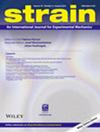Evaluation of compressive behaviour of porous structures under large deformation using micro‐CT, DVC and micro‐FE
IF 1.8
3区 材料科学
Q2 MATERIALS SCIENCE, CHARACTERIZATION & TESTING
引用次数: 0
Abstract
Compressive behaviour of open and closed cell polyurethane foam samples under large deformation is studied using micro‐Computed Tomography (micro‐CT), Digital Volume Correlation (DVC) technique and micro‐Finite Element (micro‐FE) modelling. The micro‐CT images of the foam samples at different compression strains are used to determine anisotropy in the foams, to obtain qualitative information on deformation mechanisms, to quantify the deformation and strains using a local DVC approach and to generate images for micro‐FE modelling of the foam samples. Micro‐FE modelling predicts the deformation using an elastoplastic material model coupled with continuum damage mechanics. Two different types of boundary conditions, experimentally derived (ExBC) and interpolated from DVC (IPBC), were implemented to evaluate the displacements in the micro‐FE models. A reduced integration scheme in micro‐FE analysis resulted in high artificial energy and was discarded in favour of full integration. The displacement predicted by IPBC matched with DVC displacement contours for closed cell foam. The ExBC‐predicted axial displacement (W) showed a better agreement with DVC than transverse displacements (U, V) contours. However, a significant statistical comparison (R2 > 0.70) of all displacements was obtained for both IPBC and ExBC. For open cell foam, both boundary conditions predicted a significant difference in the displacement contours with respect to DVC measurements. Still, the axial displacements of ExBC and IPBC showed a better statistical significance (R2 > 0.70).使用micro-CT、DVC和micro-FE评估多孔结构在大变形下的压缩性能
利用微计算机断层扫描(micro - CT)、数字体积相关(DVC)技术和微有限元(micro - FE)模型研究了大变形下开孔和闭孔聚氨酯泡沫试样的压缩行为。不同压缩应变下泡沫试样的微CT图像用于确定泡沫的各向异性,获得变形机制的定性信息,使用局部DVC方法量化变形和应变,并为泡沫试样的微有限元建模生成图像。微观有限元模型使用弹塑性材料模型与连续损伤力学相结合来预测变形。采用两种不同类型的边界条件,实验推导(ExBC)和从DVC (IPBC)插值(IPBC),来评估微有限元模型中的位移。在微有限元分析中,减少积分方案导致人工能量高,并被丢弃,有利于完全积分。IPBC预测的位移与闭孔泡沫的DVC位移轮廓相匹配。ExBC‐预测的轴向位移(W)比横向位移(U, V)轮廓更符合DVC。然而,IPBC和ExBC的所有移位均有显著的统计学比较(R2 > 0.70)。对于开孔泡沫,两种边界条件都预测了相对于DVC测量的位移轮廓的显著差异。但ExBC和IPBC的轴向位移有较好的统计学意义(R2 > 0.70)。
本文章由计算机程序翻译,如有差异,请以英文原文为准。
求助全文
约1分钟内获得全文
求助全文
来源期刊

Strain
工程技术-材料科学:表征与测试
CiteScore
4.10
自引率
4.80%
发文量
27
期刊介绍:
Strain is an international journal that contains contributions from leading-edge research on the measurement of the mechanical behaviour of structures and systems. Strain only accepts contributions with sufficient novelty in the design, implementation, and/or validation of experimental methodologies to characterize materials, structures, and systems; i.e. contributions that are limited to the application of established methodologies are outside of the scope of the journal. The journal includes papers from all engineering disciplines that deal with material behaviour and degradation under load, structural design and measurement techniques. Although the thrust of the journal is experimental, numerical simulations and validation are included in the coverage.
Strain welcomes papers that deal with novel work in the following areas:
experimental techniques
non-destructive evaluation techniques
numerical analysis, simulation and validation
residual stress measurement techniques
design of composite structures and components
impact behaviour of materials and structures
signal and image processing
transducer and sensor design
structural health monitoring
biomechanics
extreme environment
micro- and nano-scale testing method.
 求助内容:
求助内容: 应助结果提醒方式:
应助结果提醒方式:


